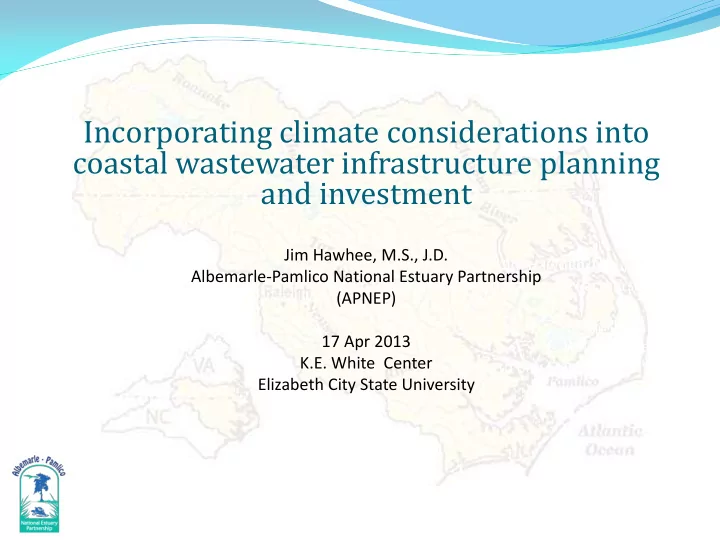

Incorporating climate considerations into coastal wastewater infrastructure planning and investment Jim Hawhee, M.S., J.D. Jim Hawhee, M.S., J.D. Albemarle-Pamlico National Estuary Partnership Albemarle-Pamlico National Estuary Partnership (APNEP) 17 April 2013 17 Apr 2013 K.E. White Center K.E. White Center Elizabeth City State University Elizabeth City State University
APNEP mission To identify, protect, and restore the significant resources of the Albemarle-Pamlico estuarine system
APNEP watershed and management area
What we’re doing… APNEP Comprehensive Conservation and Management Plan Action D3.3: Provide assistance to state, regional, and local governments to incorporate climate change and sea level rise considerations into their planning processes.
… and what we’re not House Bill 819 § 113A-107.1. Sea-level policy (b) No rule, policy, or planning guideline that defines a rate of sea- level change for regulatory purposes shall be adopted except as provided by this section.
The challenge Map credit: Dr. Tom Allen, ECU
The challenge • Small tax base • Flat topography • Storm surge vulnerability (including Hurricanes Irene, Sandy) • Projected sea level rise and associated land use changes
Project overview • Pilot test CREAT 2.0 (Climate Resilience Evaluation and Awareness Tool) and evaluate its utility for small wastewater infrastructure systems. • Provide infrastructure planning recommendations for Manteo and Columbia to consider for integration into their capital improvement planning processes.
CREAT • Software tool developed by EPA’s Climate Ready Water Utilities Program (CRWU) • Provides data from national assessment of climate change impacts. • CREAT allows users to evaluate potential impacts of climate change on their utility and to evaluate adaptation options. • CREAT provides libraries of assets (e.g., water resources, treatment plants, pump stations) possible climate change-related threats (e.g., flooding, drought, water quality), and adaptive measures.
Climate risks identified • Hurricanes • Flooding • Sea level rise • All of these issues are currently system stressors (Hurricane Irene, TS Beryl, current infiltration and inflow issues).
Pair risks with infrastructure assets • Saltwater intrusion (infiltration and inflow) / pipes • Damage to infrastructure from hurricanes and coastal storms / pump stations, treatment plants • Projected land use changes
Manteo WW System • 9 mi. gravity sewer • 3 mi. force main • 8 lift stations • Tertiary treatment • Outdated state GIS information • Substantial recent investments
Columbia WW System • little GIS information available
Characterize vulnerability for asset/threat pairs • Qualitative • Assessing consequence: low, medium, high, very high • Assess baseline and after adaptive actions adopted
Develop adaptation packages • Manteo • increase in WWTP capacity • infrastructure improvements related to flooding • Columbia • green infrastructure and sludge and biosolids management • infrastructure improvements related to flooding • saltwater intrusion • Each package provides several actions for consideration.
A deeper look at risk projections: sea level rise scenarios • Current state planning guidance only provides scenarios for 2100 (CRC Science Panel for Coastal Hazards). • CREAT integrates sophisticated national models and customizable parameters for available local data to provide sea level rise scenarios at five year intervals. • 25 and 50 year intervals selected for analysis.
Sea-level rise scenarios: CREAT SLR Rates in Manteo and Columbia: CREAT 2035 2060 High (1.5m by 2100) 8 inches 23 inches Medium (1m by 2100) 7 inches 18 inches Low (.5m by 2100) 5 inches 12 inches
Integration of local data • N.C. Coastal Atlas, in development, contains SLR projections based on work by Tom Allen (ECU): http://nccohaz.ecu.edu/coastalatlas/viewer/SLR.html • Not appropriate for site-specific analysis, but can provide local insights on the geographical patterns and extent of SLR projections over time. • Map primarily based on elevation data, with some refinements to better approximate rising water levels. • Potential uses include identifying changing land use patterns, siting infrastructure projects, or developing SLR adaptation strategies.
Lessons Learned • Local, state, and national information resources, consulted at an early stage, will improve the planning process. • Utilities using this tool might consider enlisting a small support team of utility, climate, environmental, and public health experts. • CREAT provides a methodical framework to examine climate pressures on water utility systems and develop practical solutions. • Short term climate scenarios (25-50 years), provided by CREAT, are instructive for utility planning purposes. • CREAT is an iterative process, and can be updated as new assets, threats, or solutions are identified.
Questions? Jim Hawhee jim.hawhee@apnep.org (919) 707-8632
Recommend
More recommend